
|
|
|
|
BY: SUN STAFF
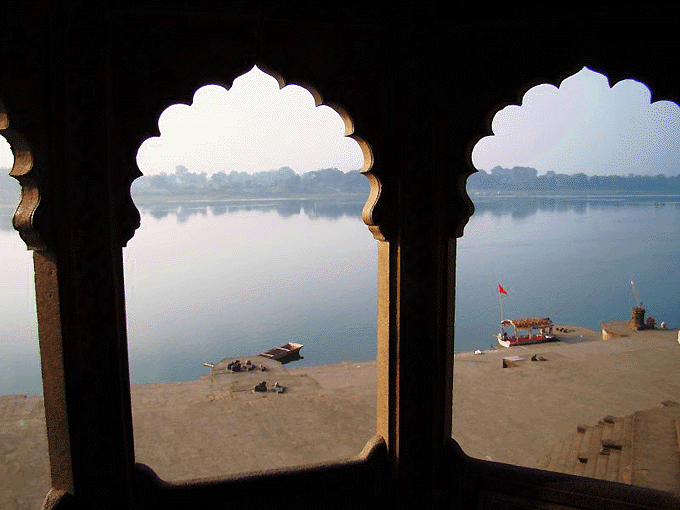
Mahismati-pura on River Narmada Feb 04, CANADA (SUN) — A serial exploration of the holy sites visited by Lord Caitanya. Mahismati-pura
In the summary of Caitanya-caritamrta Madhya lila 9, we are reading about Lord Caitanya Mahaprabhu's extensive pilgrimage to the holy sites of India. Up to now in the series, we have explored sites in South India that Mahaprabhu visited. Tonight we go north, to the state of Madhya Pradesh. About 170 kilometers east of Gujarat's eastern border, and about 80 km south of Indore there resides the ancient village of Mashismati, commonly known today as Maheswar.
Madhya Lila 9 Summary "He then went to the banks of the Krsnavenva River, where He collected from among the Vaisnava brahmanas a book written by Bilvamangala, Krsna-karnamrta. The Lord then visited Tapti, Mahismati-pura, Narmada-tira and Rsyamuka-parvata."
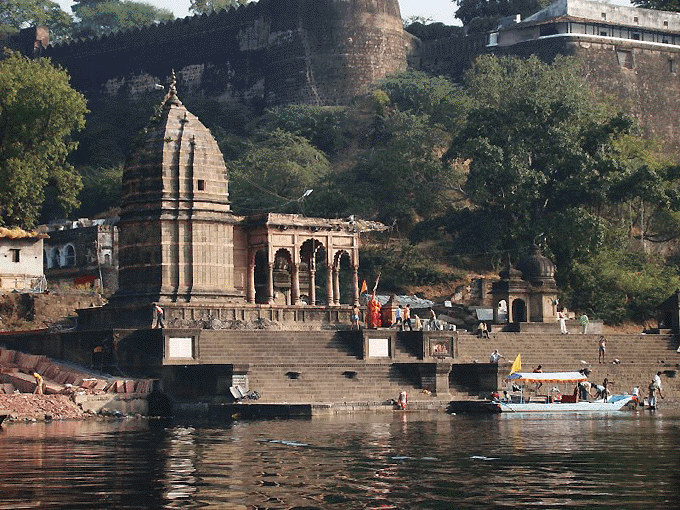
Maheswar on the Narmada In Madhya lila 9.310 we read further details of Caitanya Mahaprabhu's visit to Mahismati and the surrounding theerthams: TEXT 310
"Sri Caitanya Mahaprabhu next arrived at the banks of the river Tapi. After bathing there, He went to Mahismati-pura. While there, He saw many holy places on the banks of the river Narmada. PURPORT
The river Tapi is presently known as Tapti. The river's source is a mountain called Multai, and the river flows westward through the state of Saurastra and into the Arabian Sea. Mahismati-pura is mentioned in Mahabharata in connection with Sahadeva's victory. Sahadeva, the youngest brother of the Pandavas, conquered that part of the country. As stated in the Mahabharata:
"After acquiring jewels, Sahadeva went to the city of Mahismati, where he fought with a king called Nila."
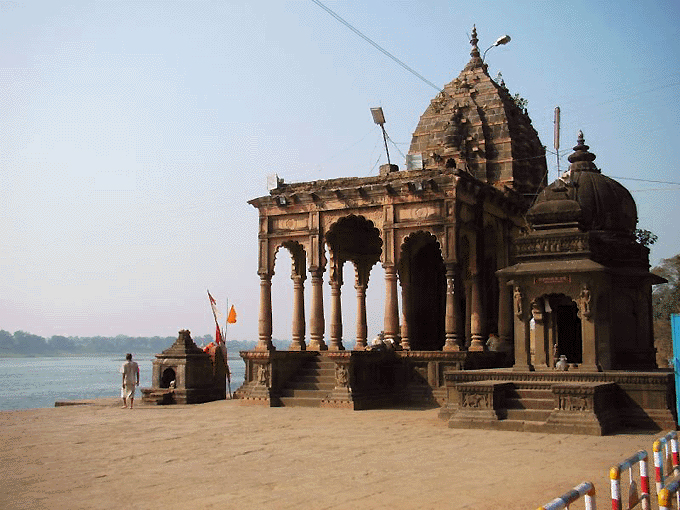
Laksmi Temple, Mahismati-pura Mahismati is an ancient city in the Khargone district of Madhya Pradesh, sitting on the banks of the sacred Narmada River. The name Mahismati-pura 'on the banks' (pura) of the Narmada. Similarly, the name Narmada-tira means 'tira', or 'the banks' of the river. The Tapti is another nearby river flowing to the Arabian Sea. In ancient times, the Kalachuris of Tripuri were the ruling house in the region, with their seat of power located at Mahismati on the Narmada. The great kings of this dynasty included Karna, Kokalla, and Gangeyadeva. Mahismati-pura was once the domain of King Indrasena, as described in this narration of Indira Ekadasi from Bhavishya Purana: "In the Satya-yuga there lived a king named Indrasena, who was so powerful that he destroyed all his enemies. His kingdom was called Mahismati-puri. The glorious and highly religious King Indrasena took good care of his subjects, and therefore he was rich in gold, grains, sons, and grandsons. He was greatly devoted to Sri Visnu as well. He especially enjoyed chanting My name, calling out ‘Govinda! Govinda!' In this way King Indrasena systematically dedicated himself to pure spiritual life and spent much time meditating on the Absolute Truth."
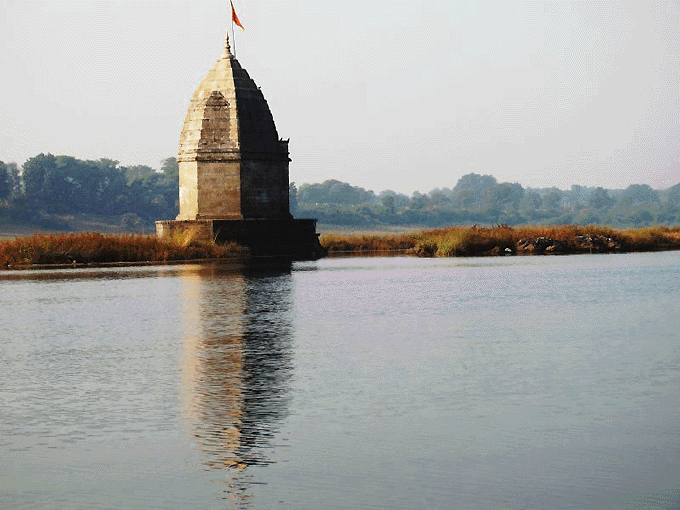
Baneswar Shiva Temple Mahismati-pura is also mentioned in the Bhavishya Purana's narration of Putrada Ekadasi. During the Dvarpara-yuga, the king of Mahismati-pura, Mahijita, had no son and so his entire kingdom seemed utterly cheerless to him. By following the sage advice of Lomasa Rishi, however, he and all the citizens of Mahismati-puri fasted on Putrada Ekadasi. On the strength of their piety, the queen became pregnant and eventually gave birth to a most beautiful son. During another age, Mahismati-pura was the capital of the princely state of Indore (originally named 'Indrapur' after Lord Indreshwar, not King Indrasena). It was rebuilt in the 18th century by Queen Ahilyabai of the Indore Holkar dynasty. A great many ancient temples, ghats and palaces are still found here, and pilgrims come in large numbers to the holy sites.
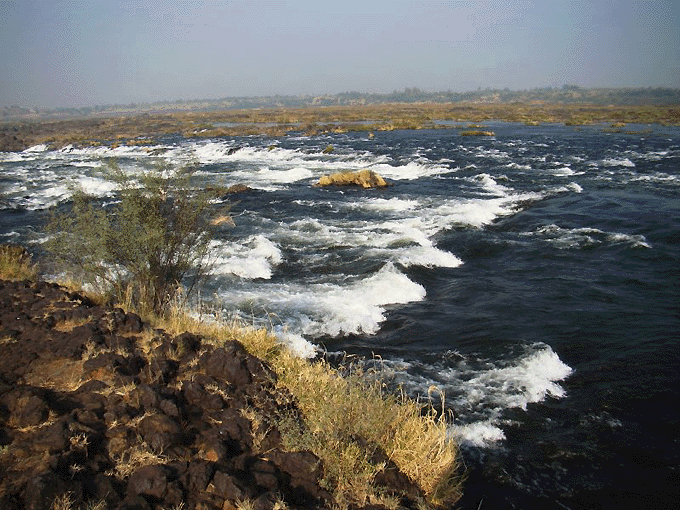
Sahasra Dhara ('a thousand streams') on the Narmada As is often the case, the place names of local villages and shrines have changed somewhat over the years. About 8 km from Mahismati (Maheswar) is a village called Mandleshwar, which is also said to have been called Mahismati in ancient times. Situated on the North bank of the river Narmada, Mandleshwar was the site of the great debate of Adi Shankarsacharya at the Gupteshwar Mahadev Temple, in which he firmly established his Mayavada philosophy. There is also a Dattatreya temple there, where strangely enough, each year abhishekha is performed in the name of Albert Einstein, and at another time in the name of Lenin. Lord Balarama at Mahismati-pura As is the case of many other places along the Lord's tirtha-yatra, Mahismati-pura was also visited by Lord Balarama and Nityananda Prabhu. Lord Balarama's pilgrimage began when He heard that the Kurus were preparing for war with the Pandavas. Being neutral, He departed on the pretext of going to bathe in holy places. (Srimad Bhagavatam 10.78) In Srimad Bhagavatam 10.79.19-21 we read:
"The Supreme Lord then traveled through the kingdoms of Kerala and Trigarta, visiting Lord Siva's sacred city of Gokarna, where Lord Dhurjati [Siva] directly manifests himself. After also visiting Goddess Parvati, who dwells on an island, Lord Balarama went to the holy district of Surparaka and bathed in the Tapi, Payoshni and Nirvindhya rivers. He next entered the Dandaka forest and went to the river Reva, along which the city of Mahishmati is found. Then He bathed at Manu-tirtha and finally returned to Prabhasa."
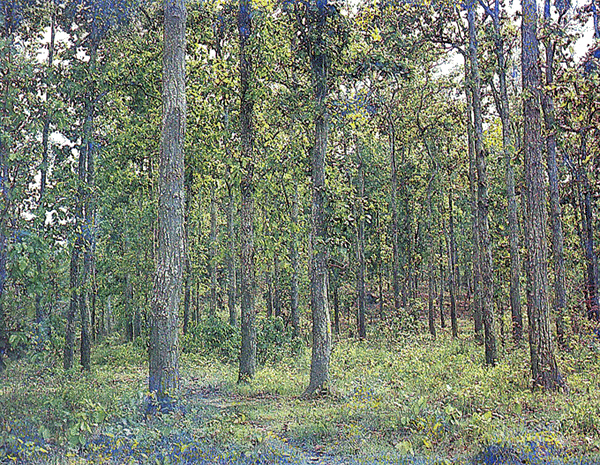
Dandaka Forest, Sangli district In Krsna Book Chapter 79, Srila Prabhupada further describes Lord Balarama's visit to Mahismati-puri, and the circumstances under which He ended his pilgrimage and returned to Kurukshetra: "From Cape Comorin Lord Balarama turned toward Kerala. The country of Kerala is still existing in southern India under the name of South Kerala. After visiting this place, He came to Gokarna-tirtha, where Lord Siva is constantly worshiped. Balarama then visited the temple of Aryadevi, which is completely surrounded by water. From that island, He went on to a place known as Surparaka. After this He bathed in the rivers known as Tapi, Payosni, and Nirvindhya, and then He came to the forest known as Dandakaranya. This is the same Dandakaranya forest where Lord Ramacandra lived while in exile. Lord Balarama next came to the bank of the river Narmada, the biggest river in central India. On the bank of this sacred Narmada there is a pilgrimage spot known as Mahismati-puri. After bathing there, according to regulative principles, Lord Balarama returned to Prabhasa-tirtha, wherefrom He had began His journey. When Lord Balarama returned to Prabhasa-tirtha He heard from the brahmanas that most of the ksatriyas in the Battle of Kuruksetra had been killed. Balarama felt relieved to hear that the burden of the world had been reduced. Lord Krsna and Balarama appeared on this earth to lessen the burden of military strength created by the ambitious ksatriya kings. This is the way of materialistic life: not being satisfied by the absolute necessities of life, people ambitiously create extra demands, and their illegal desires are checked by the laws of nature or by laws of God, appearing as famine, war, pestilence and similar catastrophes. Lord Balarama heard that although most of the ksatriyas had been killed, the Kurus were still engaged in fighting. Therefore He returned to the battlefield just on the day Bhimasena and Duryodhana were engaged in a personal duel. As well-wisher of both of them, Lord Balarama wanted to stop them, but they would not stop." Nityananda Prabhu at Mahismati-pura Nityananda Prabhu's visit to Mahismati-puri is mentioned in this biographical narrative, taken from Caitanya Bhagavata Adi-lila Chapter Nine: "At that time, the Lord arrived at the town of Kanyaka, and after visiting Durga-devi, travelled to the South Indian sea. Thereafter Nityananda Prabhu went to the town of Sri Ananta and from there to the pond of the five dancing apsaras or celestial nymphs. The Lord then visited the temple of Siva called Gokarna. He travelled from door to door over Kerala and Trigartha and after beholding the honored wife of Dvaipayana, Nityananda Prabhu travelled to Nirbindhya, Payosni, and tapti, in the course of his divine activities. He visited Reva, the town of Mahismati and Malatirtha and then the Lord turned westwards, journeying by way of Suparakha. Nityananda Prabhu was devoid of all fear. He was never afraid of anyone, throughout the whole of his travels. His body appeared weak, by reason of constant absorption in Krsna consciousness. Nityananda Prabhu laughed and cried at intervals. Who could understand his transcendental moods? Such were the travels of Lord Nityananda Prabhu as he wandered from one place to the next, visiting the holy tirthas.
| |